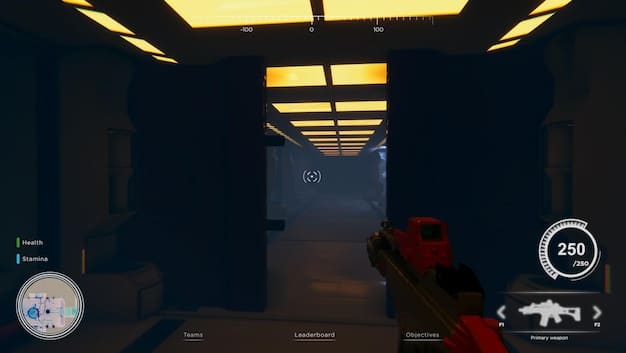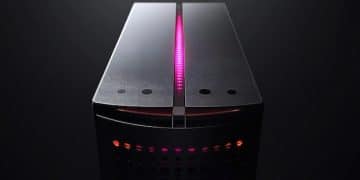Boost Your FPS in 2025: Optimize PC Gaming Performance

Boosting your FPS by 15% in 2025 requires a data-driven approach focusing on hardware upgrades, software optimization, and in-game setting adjustments to achieve smoother PC gaming performance.
Ready to experience smoother gameplay in 2025? This guide delves into proven strategies to boost your FPS by 15% in 2025: A Data-Driven Guide to Optimizing PC Gaming Performance, turning your gaming dreams into reality.
Understanding FPS and Its Impact on Gaming
Frames Per Second (FPS) is a crucial metric in PC gaming, directly influencing the smoothness and responsiveness of your gameplay. A higher FPS generally translates to a more fluid and enjoyable gaming experience, while a lower FPS can result in stuttering, lag, and a less immersive experience.
Why FPS Matters
FPS isn’t just a number; it’s the foundation of a seamless gaming session. When your frame rate drops too low, it can significantly impact your ability to react quickly and accurately in fast-paced games. This is especially critical in competitive titles where every millisecond counts.
Several factors can affect FPS, including your hardware configuration, in-game settings, and even background processes running on your computer. Understanding these factors is the first step toward optimizing your system for peak gaming performance.
- Visual Smoothness: Higher FPS reduces motion blur and delivers a clearer picture.
- Reduced Input Lag: Faster frame rates minimize the delay between your actions and the game’s response.
- Competitive Edge: In competitive games, higher FPS can provide a tangible advantage.
Ultimately, maintaining a stable and high FPS is essential for enjoying PC gaming to its fullest potential. By understanding the factors that impact FPS and implementing effective optimization strategies, you can ensure a smoother and more immersive gaming experience.
In conclusion, FPS is a cornerstone of PC gaming performance, affecting everything from visual smoothness to competitive advantage. Monitoring and optimizing FPS is a continuous process, but the rewards are well worth the effort.

Analyzing Your Current Gaming Performance
Before diving into optimization, it’s vital to understand your current gaming performance. This involves assessing your average FPS in different games and identifying any bottlenecks in your system. Tools like built-in game overlays, FRAPS, and MSI Afterburner can provide real-time FPS monitoring.
Benchmarking Your System
Benchmarking provides a standardized way to measure your system’s performance under various conditions. Use benchmark tools like 3DMark or Unigine Heaven to objectively assess your GPU and CPU capabilities. Compare your scores with similar systems to identify potential performance gaps.
Pay attention to the minimum, average, and maximum FPS recorded during your benchmarks. A significant difference between the average and minimum FPS may indicate instability or hardware limitations that need to be addressed.
- Identify Bottlenecks: Determine whether your CPU or GPU is limiting performance.
- Monitor Temperatures: Ensure your components are not overheating, which can cause throttling and reduced FPS.
- Track Resource Usage: Keep an eye on CPU, GPU, and RAM usage during gameplay.
Once you have a clear understanding of your system’s current performance, you can tailor your optimization efforts to target the specific areas that need the most improvement. This data-driven approach ensures that you’re focusing on the most effective solutions for your particular setup.
In summary, analyzing your current gaming performance through benchmarking and monitoring is crucial for identifying bottlenecks and tailoring optimization strategies. This step lays the groundwork for achieving significant FPS improvements.
Hardware Upgrades for a Noticeable FPS Boost
One of the most effective ways to boost your FPS by 15% in 2025: A Data-Driven Guide to Optimizing PC Gaming Performance is through hardware upgrades. While this can be a more expensive option, the performance gains can be substantial, especially if your current hardware is outdated.
Choosing the Right Components
Selecting the right hardware for your gaming PC requires careful consideration of your budget, performance goals, and the specific games you want to play. Focus on components that will provide the most significant impact on FPS, such as your graphics card and CPU.
Consider upgrading your graphics card to a newer model with more VRAM and improved processing power. A faster CPU can also help reduce bottlenecks and improve overall system performance, especially in CPU-intensive games.
- Graphics Card (GPU): The most critical component for gaming.
- Central Processing Unit (CPU): Important for handling game logic and physics.
- RAM (Memory): Ensure you have enough RAM (at least 16GB) for smooth multitasking and gaming.
Beyond the core components, consider upgrading your storage to an NVMe SSD for faster loading times and improved system responsiveness. A high-quality power supply unit (PSU) is also essential to ensure stable and reliable power delivery to your components.
In conclusion, hardware upgrades can significantly improve your gaming performance, but it’s essential to choose the right components based on your budget and performance goals. Prioritize upgrades that address the specific bottlenecks in your system for the most effective results.
Software Optimization Techniques for Improved FPS
Software optimization plays a critical role in maximizing your gaming performance. These techniques involve tweaking settings within your operating system, game settings, and graphics drivers to reduce overhead and improve FPS.
Optimizing Windows Settings
Your operating system can have a significant impact on gaming performance. Disabling unnecessary background processes, adjusting power settings, and optimizing visual effects can free up resources and improve FPS. Consider using a lightweight operating system or a dedicated gaming mode to further enhance performance.
Keep your drivers updated to ensure compatibility and optimal performance. Regularly check for updates from your graphics card manufacturer (NVIDIA or AMD) and install the latest drivers to take advantage of performance improvements and bug fixes.
- Disable Background Apps: Close unnecessary programs to free up resources.
- Adjust Power Settings: Set your power plan to “High Performance” for optimal performance.
- Update Graphics Drivers: Keep your drivers up-to-date for the latest performance enhancements.
Additionally, consider defragmenting your hard drive (if you’re not using an SSD) and running a disk cleanup to remove unnecessary files. Regularly maintaining your system can help prevent performance degradation over time.
In summary, software optimization techniques can significantly improve your gaming performance by reducing overhead and freeing up system resources. By tweaking Windows settings, updating drivers, and maintaining your system, you can ensure a smoother and more responsive gaming experience.

In-Game Settings: Striking the Right Balance
Adjusting in-game settings is a crucial aspect of optimizing your FPS. Finding the right balance between visual quality and performance can be challenging, but it’s essential for achieving a smooth and enjoyable gaming experience.
Key Settings to Tweak
Start by lowering the resolution, as this has the most significant impact on FPS. Experiment with different resolutions to find a sweet spot that provides a good balance between visual clarity and performance. Reducing texture quality, shadows, and anti-aliasing can also significantly improve FPS without drastically impacting visual fidelity.
Disable unnecessary visual effects such as motion blur, depth of field, and ambient occlusion. These effects can be taxing on your system and often provide minimal visual improvements. Consider using adaptive sync technologies like NVIDIA G-Sync or AMD FreeSync to reduce screen tearing and improve visual smoothness.
- Resolution: Lowering the resolution can significantly boost FPS.
- Texture Quality: Reducing texture quality can free up VRAM and improve performance.
- Shadows: Shadows are often performance-intensive; consider disabling or lowering their quality.
Pay attention to the performance impact of each setting and adjust them accordingly. Use built-in FPS counters or third-party tools to monitor your FPS while tweaking settings. This data-driven approach allows you to make informed decisions about which settings to prioritize.
In conclusion, striking the right balance with in-game settings is crucial for optimizing your FPS. By carefully adjusting resolution, texture quality, shadows, and other visual effects, you can achieve a smoother and more enjoyable gaming experience without sacrificing too much visual fidelity.
Maintaining Optimal Performance in the Long Run
Optimizing your PC for gaming is an ongoing process, not a one-time fix. To ensure sustained performance improvements, it’s essential to adopt good maintenance habits and stay informed about the latest hardware and software developments.
Regular Maintenance and Monitoring
Regularly clean your PC to prevent dust buildup, which can cause overheating and reduced performance. Monitor your system temperatures and resource usage to identify potential issues before they escalate. Keeping your drivers and operating system up-to-date is also essential for maintaining optimal performance.
Stay informed about the latest hardware and software developments to take advantage of performance improvements and new technologies. Consider upgrading your hardware periodically to keep pace with the demands of newer games. Explore overclocking options to push your hardware to its limits, but proceed with caution and ensure proper cooling.
- Dusting: Keep your PC clean to prevent overheating.
- Monitoring Temperatures: Use monitoring software to track temperatures and identify potential issues.
- Staying Informed: Stay up-to-date with the latest hardware and software developments.
By adopting good maintenance habits and staying informed, you can ensure that your PC continues to deliver optimal gaming performance for years to come. This proactive approach will help you avoid performance degradation and enjoy a consistently smooth and immersive gaming experience.
In summary, maintaining optimal performance in the long run requires regular maintenance, monitoring, and staying informed about the latest hardware and software developments. This proactive approach will help you avoid performance degradation and enjoy a consistently smooth gaming experience.
| Key Point | Brief Description |
|---|---|
| 🚀 Hardware Upgrades | Upgrade GPU or CPU for significant FPS boost. |
| ⚙️ Software Optimization | Optimize Windows and update graphics drivers. |
| 🎮 In-Game Settings | Adjust resolution and visual effects for smoother gameplay. |
| 🧹 Regular Maintenance | Clean PC, monitor temperatures, and stay informed. |
FAQ
▼
FPS stands for Frames Per Second. It measures how many frames your GPU renders each second. Higher FPS leads to smoother gameplay and better responsiveness, which improves the overall gaming experience.
▼
Many games have built-in FPS counters. Alternatively, you can use software like FRAPS, MSI Afterburner, or the NVIDIA GeForce Experience overlay to monitor your FPS in real-time while gaming.
▼
In most cases, yes. A new GPU will generally provide a noticeable FPS boost, especially if your current GPU is outdated. However, it’s essential to ensure your CPU isn’t bottlenecking the new GPU.
▼
Best techniques include disabling unnecessary background applications, updating graphics drivers, adjusting power settings to “High Performance,” and regularly cleaning your computer to prevent dust build-up and overheating.
▼
In-game settings have a significant impact. Lowering resolution, reducing texture quality, disabling shadows, and turning off visual effects can all lead to a noticeable FPS increase, which can improve the visual smoothness and gameplay.
Conclusion
Optimizing your PC for gaming in 2025 involves a combination of hardware upgrades, software tweaks, and smart in-game setting adjustments. By following this data-driven guide, you can boost your FPS by 15% in 2025: A Data-Driven Guide to Optimizing PC Gaming Performance and enjoy a smoother, more immersive gaming experience.





